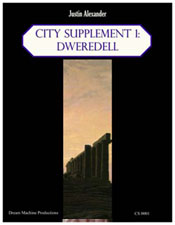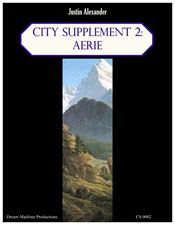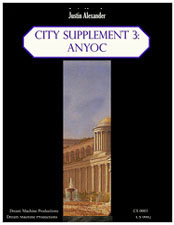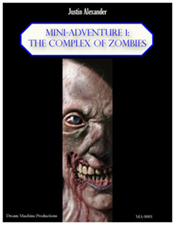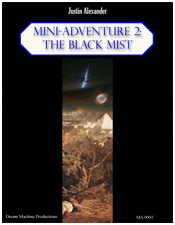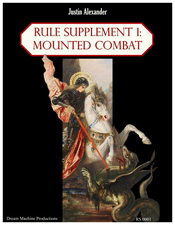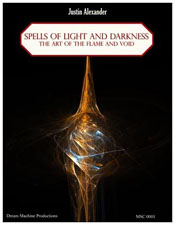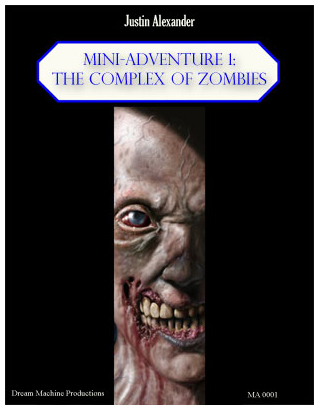I’m happy to announce the release of Mini-Adventure 2: The Black Mist.
This book is the result of a confluence of events: Several years ago I wrote several submissions for Atlas Games’ En Route II supplement. The Black Mist was originally one of them — and despite the fact that it featured what I thought was the coolest of ideas — it was the only one to be rejected. Shortly after Mini-Adventure 1: The Complex of Zombies was released, I got into a discussion over at ENWorld with James D. Hargrove. He had some very positive things to say about The Complex of Zombies:
I’m a huge, rediculous, almost sick fan of all things zombie. And I’ve always wished that the flesh-eating geeks had more, better, coverage in fantasy adventure modules. Louis Porter Jr’s Cold Visitor was, until about five minutes ago, the only example of a full-blown zombie fest (albeit one dealing with alien imitations) that I could find for [D20]. The mode (i.e., survial horror) is simply not covered well in Fantasy.
Last year, I had an opportunity to discover why such adventure are so few and far between. I talked to a publisher about writing one but, without some seriously warped interpretations of the RAW, I found that making plague a real, substantial, threat in [D20] is not at all easy. In the end, I couldn’t get the job done, much to my chagrin. I did end up writing something similar for another system but that’s a different story.
Today I found out much to my frustration that I can’t debit my bank account for anything less than $20 and, since I didn’t have $20 in it, that was a problem. So. . . what to do with that lingering $8? Hit up RPGNow, of course! I had planned on picking up some of Justin Alexander’s city modules since he posted to ‘OGL Settings’ thread here — but what really caught my eye was a little thing called “The Complex of Zombies”.
This short adventure is more or less Resident Evil in Fantasy. Which rocks. It rocks hard. And it rocks because it’s not just zombies but zombie-like things. Bad things. Bad things that eat people. Bad things that are just different enough from bog standard zombies to scare the crap out of players when they first encounter them. And all for $2.00. I’ve been looking for a promising hook to start a guilty pleasure hack and slay campaign.
And, by gawd, I think I have!
When he mentioned that he had found “making plague a real, substantial threat” to not be particularly easy it reminded me of the little encounter I had written for Atlas Games all those years ago. I went digging through my files, pulled it out, and realized that it would make a pretty awesome Mini-Adventure. Plus, it was already written! All I had to do was polish it up, re-format it for the Mini-Adventure line, and I’d be good to go!
Well, nothing is ever that simple in reality. Once I started digging into The Black Mist again, I remembered why Atlas Games had rejected it in the first place: In order to make a complex scenario fit within a very limited word count, I had used every trick in my arsenal to present as much material as quickly as possible. In fact, I’d used a few too many tricks. The Black Mist, as I had written it, was an excellent scenario… but it was more like an outline for that scenario than a fully-fledged adventure.
What was missing? All the little things that make the job DMing simple and smooth instead of laborsome and time-consuming.
So I fixed it.
With an expanded word count and 5+ years of design experience, there were lots of things that could be done. A more complete range of stat blocks was included, so that the DM would always have the appropriate stats ready and at their fingertips. The entire adventure was reorganized in a way that made it easy to use and reference the material on-the-fly. Full-color handouts were added. New rules, spells, and necromantic magic items were thrown into the mix. This took a lot more effort than the simple revision I had originally planned, but it was worth it.
The result is an exciting and terrifying journey through the horrors of a magical plague. The Black Mist can be used as an adventure in its own right, but at it’s heart it’s an event that can be used in many different ways: It can be placed center stage. It can be used as a backdrop. It can be used as a history. It can be used as a hook to even grander stories.
Without more ado, I give you…
MINI-ADVENTURE 2: THE BLACK MIST
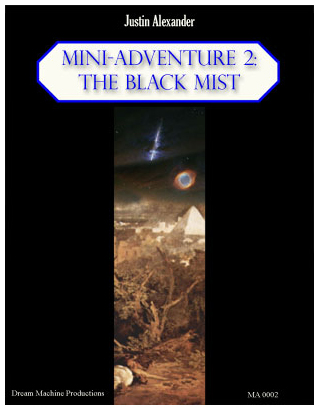 PLAGUE AND NECROMANCY…
PLAGUE AND NECROMANCY…
When a city is wracked by a magical plague that cannot be cured, the PCs are trapped inside the walls by the seal of quarantine. Will they hide from the threat of death? Or stand tall against the city’s terror?
But whatever course they choose, nothing is ever as simple as it appears. Death breeds death, and before this mist-born plague has passed the entire city will be placed in a crucible of riot and fire and necromancy…
The Black Mist features…
Full-Color Handouts
Rules for Plague
Diseased Undead
Necromantic Magic Items
New Spells
Advanced Rules for Crowds and Mobs
Advanced Rules for Large Fires
Buy PDF – Print Edition
64 pages – Handouts
The Black Mist, designed for four characters of 3rd to 5th level, can be used as an exciting adventure by itself or as the dramatic backdrop for any city-based campaign!

